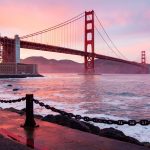The Flatiron Building, a striking triangular structure, has been a defining feature of San Francisco’s urban landscape since its completion in 1913. Located at 540 Market Street, this 10-story, 120-foot-tall building showcases the Mission Revival architectural style, a rarity in the city. The building’s design and construction involved notable architectural firms such as Havens & Toepke, who played a crucial role in shaping its unique appearance.
In This Article
Key Points
- The Flatiron Building is a pivotal piece of San Francisco’s urban and architectural landscape.
- It has played a significant role in the city’s cultural heritage and commercial development.
- The building has demonstrated remarkable resilience, surviving the devastating 1906 Earthquake and Fire.
Architectural Marvel of the Flatiron Building
Mission Revival Architecture and Its Influence
The Flatiron Building is a prime example of the Mission Revival architectural style, which draws inspiration from the early Spanish missions in California. This style is characterized by its use of stucco walls, red tile roofs, and decorative parapets, all of which are prominently featured in the Flatiron Building’s design. The building’s embrace of Mission Revival architecture sets it apart from the more common Gothic and Renaissance Revival styles found in San Francisco.
Contributions of Architectural Firms
Several renowned architectural firms contributed to the Flatiron Building’s design and construction. Havens & Toepke, the primary architects, were responsible for the building’s overall appearance and its adherence to the Mission Revival style. The firm’s decision to incorporate Mission Revival elements into a triangular building was a bold and innovative move, showcasing their creativity and adaptability.
Landmark Status and Preservation
In recognition of its historical and architectural significance, the Flatiron Building was designated as San Francisco Landmark #155 in 1982. This status ensures that the building’s architectural integrity is preserved and protected for future generations. The landmark designation process involves a thorough evaluation of a building’s historical, architectural, and cultural merits, and the Flatiron Building met these criteria with its unique design and resilience.
The Flatiron Building’s Role in San Francisco’s Urban Fabric
Intersection with Market Street and the Financial District
The Flatiron Building’s strategic location at the intersection of Market Street and Sutter Street places it at the heart of San Francisco’s Financial District. Its triangular shape, dictated by the diagonal path of Market Street, has had a significant impact on the urban grid and commercial development in the area. The building’s presence has helped to define the character and vibrancy of this bustling commercial hub.
Historical Significance and Urban Development
The Flatiron Building’s survival of the 1906 Earthquake and Fire is a testament to its structural integrity and resilience. In the aftermath of the disaster, the building played a crucial role in the city’s reconstruction and urban development efforts. Its continued presence in the Financial District has contributed to the area’s growth and evolution over the past century.
Triangular Buildings and Urban Planning
Triangular buildings, like the Flatiron Building, are a product of urban planning and development strategies that seek to maximize the use of irregularly shaped plots of land. These buildings, often found at the intersection of diagonal streets and the urban grid, have become iconic landmarks in cities across the United States. The Flatiron Building in San Francisco is a prime example of how triangular buildings can contribute to a city’s architectural heritage and urban fabric.
Cultural and Commercial Hub
Historical Buildings and Cultural Heritage
The Flatiron Building is more than just an architectural marvel; it is also a testament to San Francisco’s rich cultural heritage and history. Its neighbors, such as Caffe Trieste, American Zoetrope, and Cafe Zoetrope, have played significant roles in the city’s cultural scene. Caffe Trieste, for example, is known as a gathering place for artists, writers, and musicians, while American Zoetrope is a film production company founded by renowned director Francis Ford Coppola.
Modern Commercial Use
Despite its historical significance, the Flatiron Building has adapted to meet the needs of modern commercial tenants. The building currently houses the headquarters of Boutique Air, a regional airline, as well as offices for TextNow and Jimdo, both technology companies. This balance between preserving historical integrity and accommodating contemporary commercial needs demonstrates the building’s versatility and enduring appeal.
San Francisco Architecture Tours
The Flatiron Building’s unique architecture and historical significance have made it a popular stop on San Francisco architecture tours. These tours highlight the building as a prime example of Mission Revival architecture and its role in the city’s post-earthquake urban resilience. By featuring the Flatiron Building, these tours help to educate visitors and locals alike about the importance of preserving San Francisco’s architectural heritage.
The Flatiron Building and San Francisco’s Real Estate
Impact on San Francisco Real Estate
Iconic buildings like the Flatiron Building have a significant impact on San Francisco’s real estate market. The presence of such historically and architecturally significant structures can influence property values and urban development strategies in the surrounding area. The Flatiron Building’s enduring appeal and its role in defining the character of the Financial District have contributed to the area’s desirability and economic vitality.
Challenges and Opportunities in Preservation
Preserving historical buildings like the Flatiron Building within a rapidly evolving urban and real estate landscape presents both challenges and opportunities. The costs associated with maintaining and upgrading these structures to meet modern safety and accessibility standards can be substantial. However, the successful integration of historical preservation with modern urban development can create unique and vibrant communities that celebrate a city’s past while embracing its future.
FAQ
What is the architectural style of the Flatiron Building in San Francisco?
The Flatiron Building in San Francisco is designed in the Mission Revival architectural style, which is characterized by its use of stucco walls, red tile roofs, and decorative parapets.
Who were the architects and firms involved in the design and construction of the Flatiron Building?
The primary architects of the Flatiron Building were Havens & Toepke, who were responsible for the building’s overall appearance and its adherence to the Mission Revival style.
How did the 1906 Earthquake and Fire affect the Flatiron Building?
The Flatiron Building survived the devastating 1906 Earthquake and Fire, demonstrating its structural integrity and resilience. The building played a crucial role in San Francisco’s recovery and urban development efforts in the aftermath of the disaster.
What is the significance of the Flatiron Building in San Francisco’s urban landscape?
The Flatiron Building has had a significant impact on San Francisco’s urban grid, commercial development, and architectural heritage. Its triangular shape, dictated by the diagonal path of Market Street, has helped to define the character and vibrancy of the Financial District.
How is the Flatiron Building used today?
Today, the Flatiron Building houses the headquarters of Boutique Air, a regional airline, as well as offices for technology companies TextNow and Jimdo. The building’s ability to accommodate modern commercial tenants while preserving its historical integrity demonstrates its versatility and enduring appeal.

